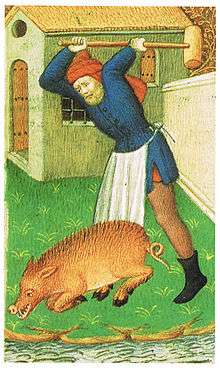Stunning

Stunning is the process of rendering animals immobile or unconscious, with or without killing the animal, when slaughtering them for food.
History

A primitive form of stunning was used in premodern times in the case of cattle, which were poleaxed prior to being bled out. However, prior to humane slaughter pistols and electric stunners, pigs, sheep and other animals (including cattle) were simply struck while fully conscious.
The belief that this was unnecessarily cruel and painful to the animal being slaughtered eventually led to the compulsory adoption of stunning methods in many countries. One of the first campaigners on the matter was the eminent physician, Benjamin Ward Richardson, who spent many years of his later working life developing more humane methods of slaughter. As early as 1853, he designed a lethal chamber that would gas animals to death relatively painlessly, and he founded the Model Abattoir Society in 1882 to investigate and campaign for humane methods of slaughter. He even experimented with the use of electric current at the Royal Polytechnic Institution.[1]
The development of stunning technologies occurred largely in the first half of the twentieth century. In 1911, the Council of Justice to Animals (later the Humane Slaughter Association) was created to improve the slaughter of livestock and address the killing of unwanted pets.[2] In the early 1920s, HSA introduced and demonstrated a mechanical stunner, which led to the adoption of humane stunning by many local authorities."[3]
The HSA played a key role in the passage of the Slaughter of Animals Act 1933. This made the mechanical stunning of cows and electrical stunning of pigs compulsory, with the exception of Jewish and Muslim meat.[3] Modern methods, such as the captive bolt pistol and electric tongs were required and the Act's wording specifically outlawed the poleaxe. The period was marked by the development of various innovations in slaughterhouse technologies, not all of them particularly long-lasting.
Modern methods
In modern slaughterhouses a variety of stunning methods are used on livestock. Methods include:
- Electrical stunning
- Gas stunning
- Percussive stunning
Electrical stunning
Electrical stunning is done by sending an electric current through the brain and/or heart of the animal before slaughter. Current passing through the brain induces an immediate but non-fatal general convulsion that produces unconsciousness. Current passing through the heart produces an immediate cardiac arrest that also leads shortly to unconsciousness and death. It is a controversial subject however. With chickens for example, overstunning leads to bone fractures and/or electrocution which prevents bleeding of the animal. This negatively affects the quality of the meat, and therefore understunning is an attractive practice for slaughterhouses.
In the Netherlands, for example, the law states that poultry must be stunned for 4 seconds minimum with an average current of 100 mA, which leads to systematic understunning.
The CrustaStun is a device designed to administer a lethal electric shock to shellfish (such as lobsters, crabs, and crayfish) before cooking. This avoids boiling a live shellfish which may be able to experience pain in a way similar to vertebrates. The device works by applying a 110 volt, 2–5 amp electrical charge to the animal. It is reported the CrustaStun renders the shellfish unconscious in 0.3 seconds and kills the animal in 5 to 10 seconds, compared to 3 minutes to kill a lobster by boiling or 4.5 minutes for a crab.[4][5]
Percussive stunning
With percussive stunning, a device which hits the animal on the head, with or without penetration, is employed. Such devices, such as the captive bolt pistol, can be either pneumatic, or powder-actuated. Percussive stunning produces immediate unconsciousness through brain trauma.
Gallery
-
.jpg)
Captive bolt pistol
-

Modern captive bolt device
-

Stunning a cow with a captive bolt
-

Directions for positioning bolt gun to ensure swift stunning
United States regulation
Stunning is regulated by the provisions of the Humane Methods of Slaughter Act (7 U.S.C. 1901), which the Food Safety and Inspection Service (FSIS) is mandated to uphold under the Federal Meat Inspection Act (21 U.S.C. 603 (b)). No similar provision exists in the Poultry Products Inspection Act of 1957 (21 U.S.C. 451 et seq.).
After confirmation of the first U.S. BSE case, FSIS issued regulations (69 FR 1887, January 12, 2004) prohibiting the use of the most widely used stunning device (air-injection captive bolt stun gun) because the compressed air (in contrast to the blank cartridge-driven or non-penetrating captive bolt) has been shown to force pieces of brain and other central nervous system (CNS) tissue into the bloodstream. Cattle blood is processed primarily for use as a protein supplement in animal feeds and milk replacer for calves, and could potentially transmit BSE if it contained specified risk materials (SRMs include brain and CNS tissue).[6]
See also
References
- ↑
 This article incorporates text from a publication now in the public domain: Power, D'Arcy (1901). "Richardson, Benjamin Ward". In Sidney Lee. Dictionary of National Biography, 1901 supplement. London: Smith, Elder & Co.
This article incorporates text from a publication now in the public domain: Power, D'Arcy (1901). "Richardson, Benjamin Ward". In Sidney Lee. Dictionary of National Biography, 1901 supplement. London: Smith, Elder & Co. - ↑ "Humane Slaughter Association Newsletter March 2011" (PDF). Humane Slaughter Association. Retrieved 1 July 2014.
- 1 2 "History of the HSA". Humane Slaughter Association. Retrieved 1 July 2014.
- ↑ McSmith, A. (November 21, 2009). "I'll have my lobster electrocuted, please". London: The Independent (Newspaper). Retrieved June 14, 2013.
- ↑ Anon. (October 27, 2010). "CrustaStun: The 'humane' gadget that kills lobsters with a single jolt of electricity". London: MailOnline (Newspaper). Retrieved June 14, 2013.
- ↑ CRS Report for Congress: Agriculture: A Glossary of Terms, Programs, and Laws, 2005 Edition - Order Code 97-905
External links
| Look up stunning in Wiktionary, the free dictionary. |
- The Food and Agricultural Organisation (FAO) outlines practical suggestions for humane handling and slaughter of livestock.
